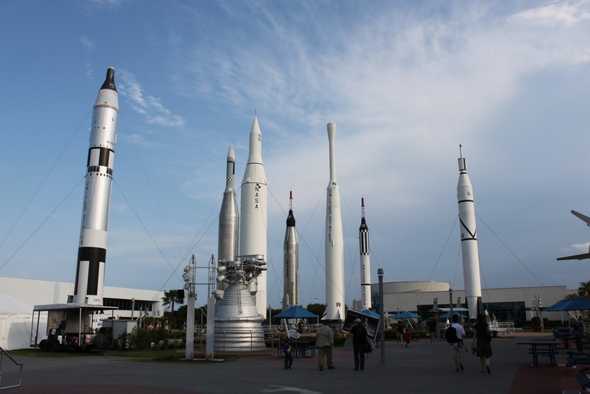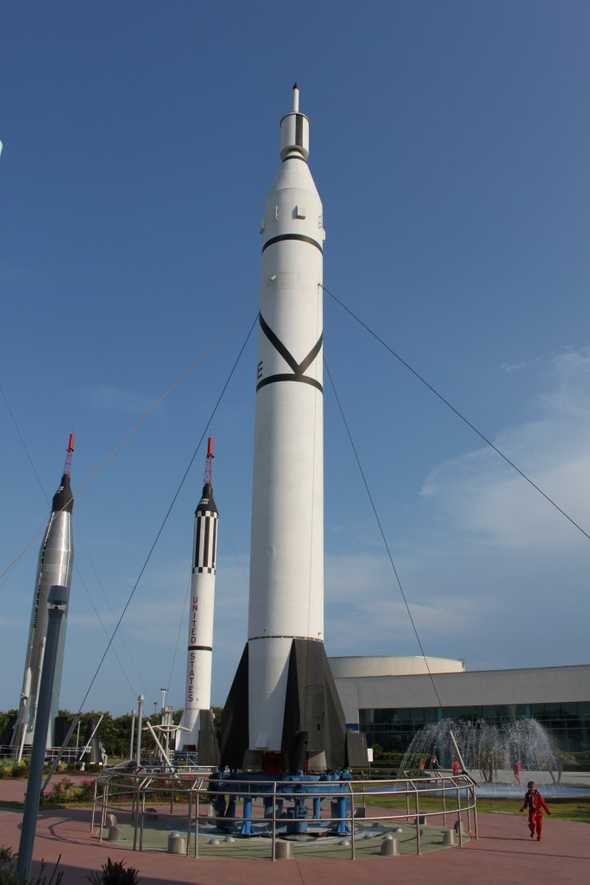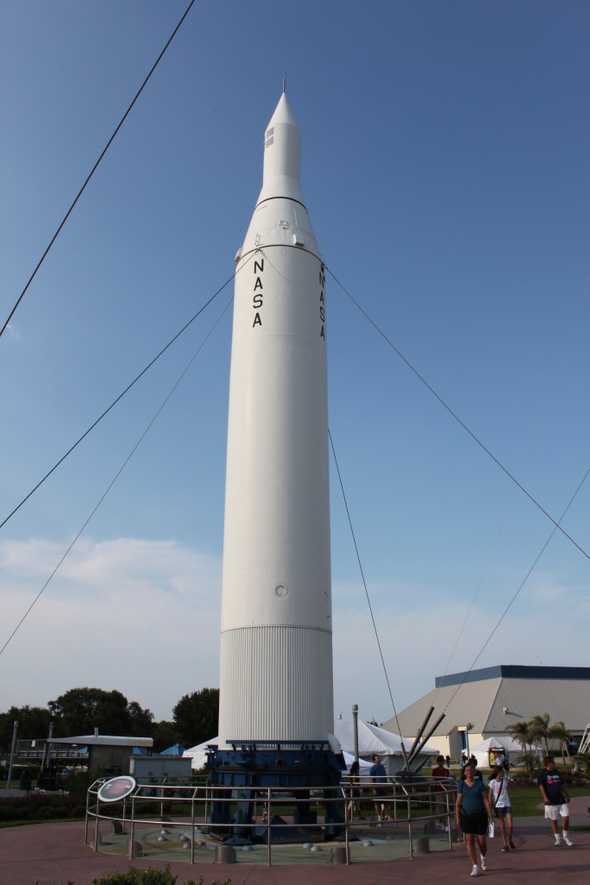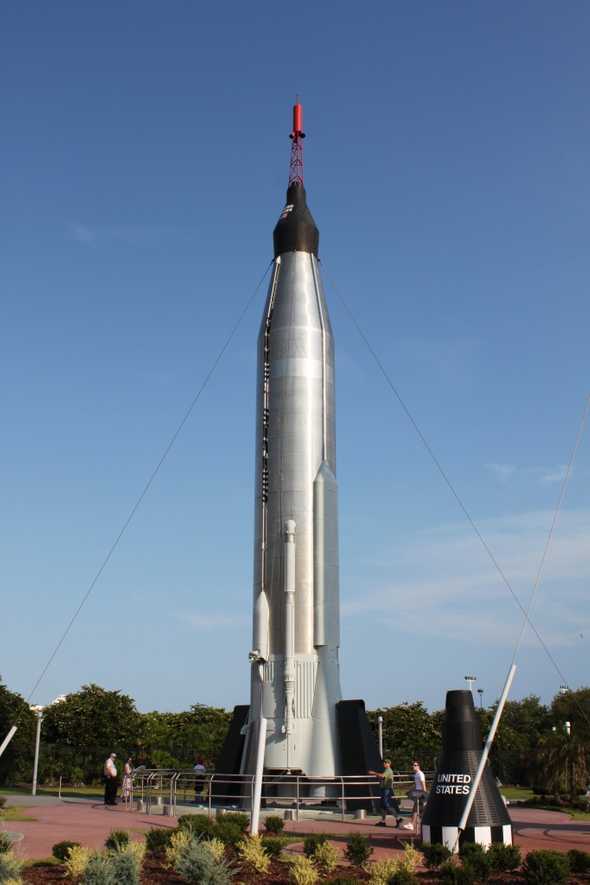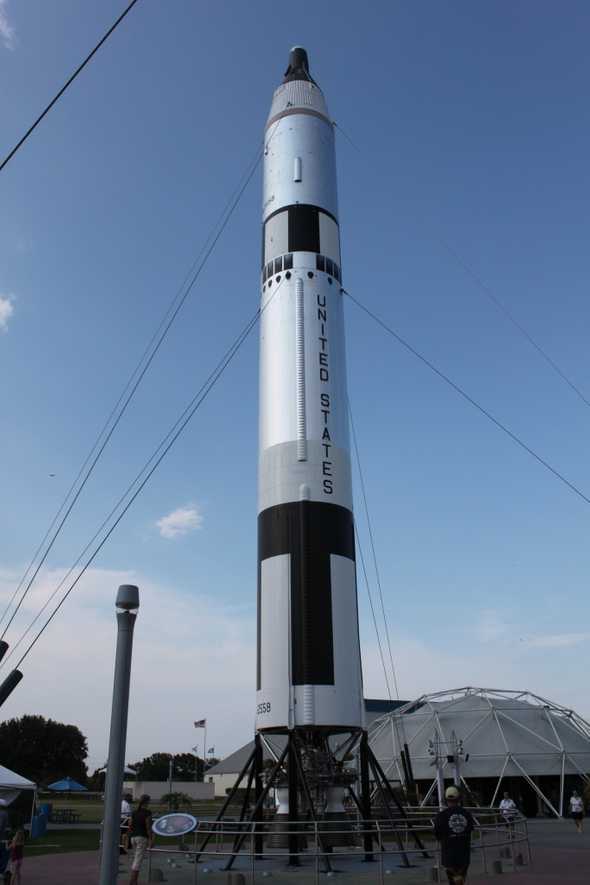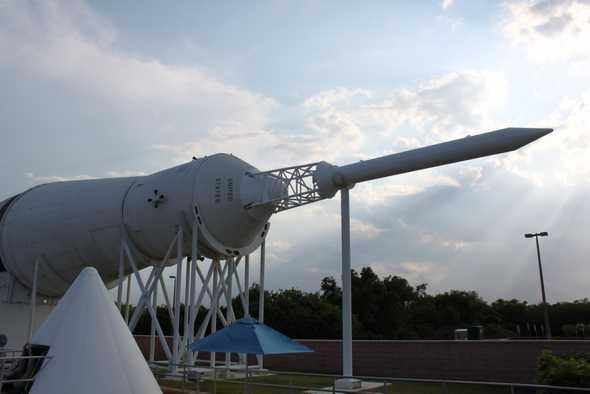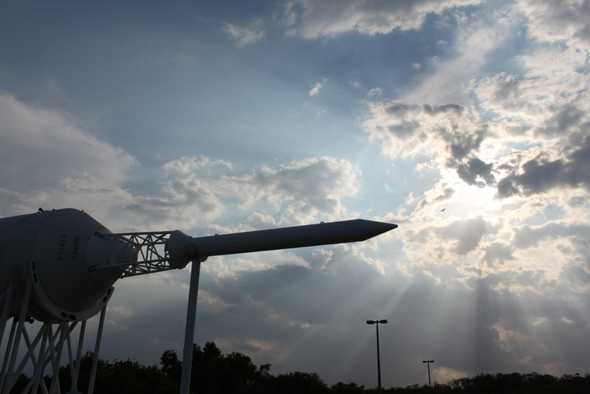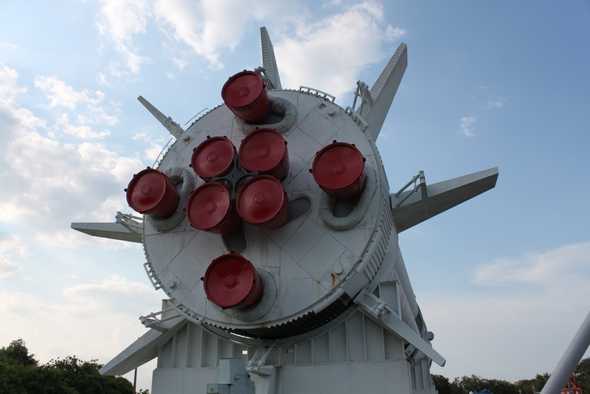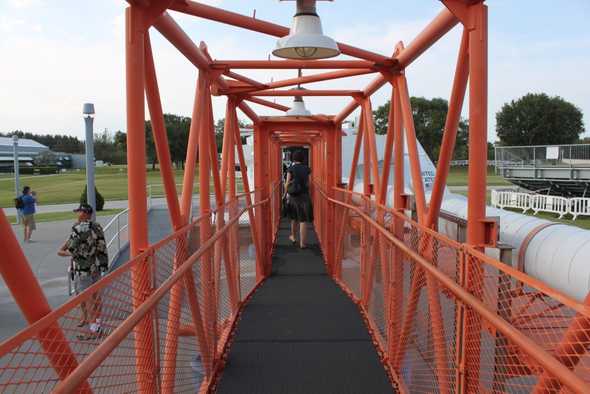Rocket Garden
The Rocket Garden at the Kennedy Space Center Visitor Complex in Florida features eight rockets including: Juno I, Juno II, Delta, Mercury Redstone, Atlas-Agena, Mercury Atlas, Gemini - Titan, and Saturn IB.
1957: Cold war Co-OperationAt the height of the Cold War mistrust, scientists from around the world pressed for international co-operation in finding out more about the Sun, the Earth and its atmosphere. From July, 1957 to December, 1958, scientists from 67 nations worked together to fill a pool of geological information that is still in use. Named the International Geophysical Year, it was the first sign of Spring for a world frozen in fear of nuclear war.
A major contribution to this information pool was made by Explorer I. A Juno I rocket launched the 11-pound satelite into orbit where it detected vast layers of energy-emitting particles. These layers were later named the Van Allen Belts after James A. Van Allen, the American astrophysicist who built the instruments carried by Explorer I.
The particles in the Van Allen Belts are believed to be pieces of the Sun, exploding into Space during Solar Flares and captured by Earth’s gravity.
Chasing The Russian BearSpace was just for Science Fiction fans until the world’s first man-made satellite - the USSR’s Sputnik - beep, beep, beeped down at us from orbit. Hawks imagined a future with orbiting bomb platforms and spies in the sky; Doves saw it as the dawn of a new beginning for humankind.
Either way, America had to get something in orbit in a hurry if we were to be included in a race that had started without us. Atop a Redstone rocket, the military’s 2-stage Jupiter was stacked with an added fourth stage. Re-named Juno I, the 4-stage rocket pushed the 11-pound Explorer I satellite into orbit on January 31, 1958.
ROCKET DATA: Juno I Height; 21.7 meters (71.25 feet) Diameter: 1.8 meters (70 inches) First stage propellants: Liquid Oxygen (LOX) and Hydyne Upper stage propellants: Solid Lift-off thrust: 83,000 pounds
Learning to Phone HomeThe first challenge was getting the hardware up there. But even the biggest rocket would be no more than fireworks if we couldn’t ride along — even if it was just electronically for the first time being. The devices and systems we needed for Space exploration — 2-way communications to guide our payloads to exact destinations, to set them to work gathering data and sending it home — began in earnest with the Pioneer program: Unmanned rockets to the Moon.
Pioneer 4, sent aloft aboard the Juno II on March 3, 1959, flew past the Moon and into an orbit around the Sun. It sent home a huge cache of information that was received at the brand new commuincations complex at Goldstone Lake, California. Designed and managed by Jet Propulsion Labs, this was the birth of the Deep Space Communications Network, our telephone to the stars.
Shooting the Moon, Dreaming of StarsAmerica’s newfound enthusiasm for Space opened the door to an army of scientific visionaries who had dreamed of this opportunity for generations. It wasn’t just telescopes anymore. It was going there, taking notes, building the immeasurable library of knowledge we’d need to understand this mysterious environment and design the systems we’d need to make it safe for human exploration.
Pioneer 4 was our first mission to make it to the Moon. It was the second, and last, use of the Juno II. This rocket paved the way for 33 unmanned American missions to the Moon carried by more powerful rockets.
ROCKET DATA: Juno II Height: 23.4 meters (76.7 feet) Diameter: 2.67 meters (105 inches) First stage propellants: Liquid Oxygen (LOX) and Kerosene Upper stage propellants: Solid Lift-off thrust: 150,000 pounds
Global Television ArrivesIn 1960, the first live television signal to cross an ocean created an instant sensation — and spawned a communication revolution. This signal was bounced off a huge Mylar balloon we called Echo, launched into orbit by a Delta Rocket in August 1960.
Just two years later, another Delta rocket launched Telstar, the first telecommunications satellite, into orbit. Telstar could receive, amplify and transmit intercontinental television signals in real time. Suddenly, world events were unfolding in our living rooms to put a human face on history.
The Sun Rides A WorkhorseThe Delta was the fourth configuration of the Thor-Able launch vehicle. Not part of the manned space program, this rocket never archieved the fame of the Redstone, Atlas or Saturn. Yet, in all its 34 versions, the Delta has been the workhorse of America’s exploration of the world beyond our own. Its exceptional reliability made it the launch vehicle of choice for many of the most significant breakthroughs of our time.
When it launched the Deep Space Probe, Pioneer 5, on March 11, 1960, the beach ball-sized spacecraft was equipped with four paddle like solar cells that recharged the on-board batteries that provided electrical power. Invented in 1941 by American Russell Ohl, improved solar cells have become a reliable source of electrical power for satellites and the International Space Station.
ROCKET DATA: Delta Height: 27 meters (89.3 feet) Diameter: 2.24 meters (88.9 inches) First stage propellants: Liquid Oxygen (LOX) and kerosene Second and Thrid stage propellants: Solid Lift-off thrust: 152,000 pounds
Sharing The Ride Around The WorldAs the flights of Project Mercury were planned, we knew we need uninterrupted communication with man and machine as they flew around the world. Life support systems, speed, attitude, position — a thousand bits of data — had to be watched continuously to get the “A-OK” signals that punctuated the entire race to the Moon for a watching world. Mission Control had to be the world’s biggest earthbound dashboard — an unfailing connection to every craft we sent aloft — each instrument watched by a hundred pairs of expert eyes.
To do the job, NASA built 13 strategically located stations around the world, creating the first Global Communication Network. State of the art technology for its time, the system grew to become a vital part of the most sophisticated Galactic communications network on Earth by the time the Apollo missions to the Moon were completed.
We Could Lose HimWe took every precaution. Stretched technology to unimagined limits. Installed back-up systems for everything. And tested and tested it over and over again. But nothing we could do would give us a 100% guarantee that we would not lose Commander Alan Shepard on May 5, 1961 when he said, “C’mon…let’s light this candle,” and became our First American in Space.
Strapped into the driver’s seat of his tiny Mercury Capsule, Freedom 7, he rode his Redstone rocket 115 miles up and landed successfully 302 miles down range. Secretly, a thousand fingers uncrossed and relaxed.
ROCKET DATA: Mercury Redstone Height: 25.3 meters (83 feet) Diameter: 1.8 meters (70 inches) Fuel: Liquid Oxygen (LOX) and Alcohol-Water Lift-off thrust: 78,000 pounds
Learning To DriveThe Atlas rocket gave us the power to attain an orbit, but it was the Agena on top that bridged the huge gap between getting there and getting down to work. The Agena was powered by an engine we could turn on and off at will. It was also the first to have a steering system to meet the Gemini program’s mission objectives: To rendezvous and dock with other spacecraft.
Up to this point, the brute force of Russia’s rocket technology had earned them all the trophies. But the Atlas-Agena brought us to the turning point in the Space race. American’s leadership in electronic and systems technology would keep us driving circles around the Russians from here all the way to the Moon.
Aiming At The HeavensWith the newfound power and guidance combination of the Atlas-Agena system, we now had the ability to successfully aim unmanned exploratory missions at other worlds. Teams of scientists who could explore the heavens with telescopes until now, set about building Robot Scouts to extend our curious eyes and ears into space.
In January 1962, the Atlas-Agena launched Ranger 3 and sent it racing toward the Moon. The plan was to capture and send home pictures of the Moon until impact with the lunar surface. But Rogers 3 missed the target and headed for the Sun. There were eight missions in the Ranger program. They sent back more than 11,000 detailed pictures of the Lunar surface, including close-ups of the Sea of Tranquility where Apollo 11 would touch down in 1969.
ROCKET DATA: Atlas-Agena Height: 27.7 meters (91 feet) Diameter Atlas: 3 meters (10 feet) Diameter Agena: 1.5 meters (5 feet) Atlas propellants: Liquid Oxygen and RD-1
Inventing EverythingNot since World War II had Americans been so galvanized to a single goal as we were when pointed towards the Moon by President Kennedy. But to fulfill NASA’s mission to put an American on the Moon before the end of the decade, we had to invent everything from scratch, including the Mission Control procedures, the tracking and communications systems — even the test methods and equipment to prove it all worked. And we had to get it underway with computers the size of boxcars, slide rulers instead of calculators, and communications systems not much better than jungle drums — at least in the beginning.
The Power To Get ThereWith the Russians out in front of us and the Press breathing down our necks, the reliable Redstone ballistic missile was chose to launch the first two Americans into sub-orbital flights. But even before Commander Alan Shepard’s historic flight on May 5, 1961, flight tests of the more powerful Atlas rocket were underway. Stuffed inside the Friendship 7 spacecraft, the Atlas launched John Glenn on his historic three-orbit flight on February 20, 1962. He proved humans could work in a weightless environment, piloting the Friendship 7 for most of the flight after automatic attitude systems failed.
ROCKET DATA: Mercury Atlas Height: 29 meters (95.4 feet) Diameter: 3 meters (10 feet) Fuel: Liquid Oxygen (LOX) and Kerosene Lift-off thrust: 367,000 pounds
Working in Space, Two By TwoIf the Mercury missions proved that humans could survive and work in the most hostile environment ever explored, it was the Gemini program that tested and proved the skills and systems we needed to get the Moon back. On June 3, 1965, Ed White cracked the hatch on Gemini IV and took America’s first spacewalk. Other astronauts stayed in orbit just 6 hours short of two weeks. Ground Control perfected multi-vehicle management. We learned to navigate, to rendezvous and dock. With every mission we raised the curtain on a score of mysteries before the astonished eyes of a worldwide audience.
Swords Into PlowsharesLooking into the rearview mirror, we can only shake our heads at the fear and paranoia that chained two powerful nations to a seesaw of guided missiles and nuclear destruction. But we should also remember that it was the Cold War between the USSR and America that triggered the greatest human adventure in recorded history.
The Titan II was an Intercontinental Ballistic Missile. It was designed to deliver nuclear weapons across oceans to the military and population centers of a nation we believed threatened our country’s survival. As a reliable weapon of the Cold War, the last Titan was decommissioned in 1987. Yet it was the very reliability of this rocket that made it a logical choice as launch vehicle for the Gemini missions in 1965 and 1966. The Titan II helped keep the Gemini astronauts safe. We will never really know if it did the same for the rest of us all those years.
ROCKET DATA: Gemini - Titan Height: 33.2 meters (109 feet) Diameter: 3.05 meters (130 inches) First and second stage propellants: Unsymmetrical dimethyl hydrazine and nitrogen tetroxide oxidizer Lift-off thrust: 430,000 lbs.
Shaping Things to ComeLess than three years after Sputnik, NASA began test firing the Saturn I, the first launch vehicle created specifically for the program. It was the largest rocket ever built in America and led to the development of the huge Saturn V. The Saturn IB was used to launch the unmanned Apollo 5 and the three-man Apollo 7 into orbit. It remained in service in the Apollo program until 1968.
Perhaps the most significant task of the Saturn IB was delivering the Skylab crewmembers to America’s first space station. As big as a three-bedroom house, Skylab was the largest object NASA placed in the orbit. It was occupied by a rotation of three-man crews who spent a total of 171 days on board. They performed over 300 scientific and engineering experiments, establishing procedures in use today on the International Space Station.
The End of the BeginningWhat began as a competition of fear in 1958 became a quest for common ground 17 years later. On July 15, 1975, Russia launched their Soyuz spacecraft into orbit. Seven hours later, the Saturn IB launched an Apollo Command Service Module fitted with the first international space component — a docking ring. It would enable old enemies to link up in Space, and establish a new world goal, hand in hand. 52 hours after Soyuz launch, the two craft linked up to spend two days sharing Space as one.
In our time we have been the privileged witness of “One giant leap for Mankind.” As proud a moment as it was, the giant leap wasn’t just walking on our moon. It was also a giant leap of faith — a new understanding, inspired by our first sight of this fragile Earth from Space, that we have bigger fish to fry.
Rocket Data: Saturn IB Height: 68 meters(223 feet) Diameter: 6.5 meters (225.7 inches) First stage propellants: Liquid oxygen (LOX) and Kerosene Second stage propellants: Liquid oxygen (LOX) and liquid hydrogen Lift-off thrust: 2,000,000 lbs
The Power of ApolloThe most powerful liquid-fueled rocket engine ever produced, the F-1 engine was a critical component in sending Astronauts to the moon during the Apollo program. Developed under the direction of Werner Von Braun, the Saturn V rocket was the largest operational launch vehicle ever produced. Standing 36 stories high and weighing over 6 million pounds, a cluster of five F-1 engines, generating more than 7.5 million pounds of thrust propelled the rocket to a speed of 6,000 mph and an altitude of 38 miles in just under three minutes. It was said at that time that, except for a nuclear explosion, the launching of Saturn V rocket was the loudest man made noise ever produced.
Just one F-1 engine provided as much thrust as all three Space Shuttle Main Engines combined!
Fuel: Liquid Oxygen (LOX) and rp-1 (Kerosene)
Walk With The Crew Of Apollo 11On July 16, 1969, more than 30 stories above the launch pad for the huge Saturn V rocket, Neil Armstrong, Buzz Aldrin and Michael Collins walked across this Service Arm from the Launch Tower to the Command Module of Apollo 11. Their next stop: the Moon’s Sea of Tranquility.
The Last Place on EarthHugging the side of the Apollo Command Module, the White Room was the last stop for astronauts before lift-off. Here, the White Room Crew made a final check of spacesuits and assisted the astronauts into their flight positions. They hooked them up to essential communications and life support systems, and sealed the hatch. After a final systems check, they rode the elevator down to the launch pad, leaving the rest of the Apollo mission to history.

